
WITNESS THE ANCIENT CIVILIZATION AT PHANOM RUNG HISTORICAL PARK
Phanom Rung Historical Park or Prasat Hin Phanom Rung in Thai (Prasat Hin means stone castle), set in Buriram province, where is one of must not miss cities in Thailand. The province is not renowned just only for the reputation of its football team or its world class racing track. But also, there are remarkable ancient remains called Phanom Rung Historical Park standing for a tourist to witness its elegant beauty of the antiquity site where there are spectacular attractions for many tourists from over the world to come.
About Phanom Rung Historical Park
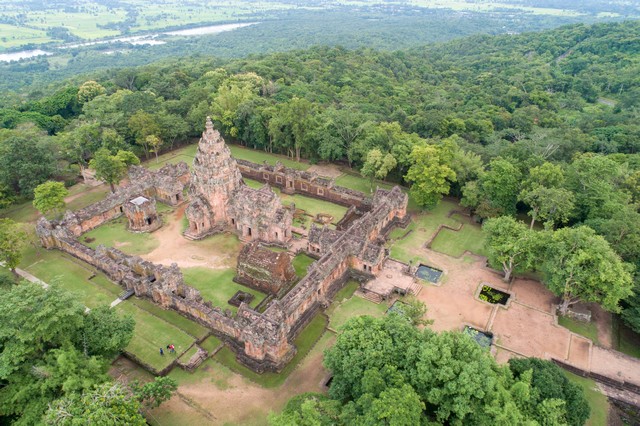
The Khmer style temple, Phanom Rung Historical Park, is part of Raja Manka Stone Castle Complex established at Ban Nong Haen, Ta Pek sub-district, Chalearm Phrakiat district, about 77 kilometers from Buriram city town. The complex consists of important ancient remains set on the rim of an extinct volcano at 350 meters above the sea level. The word “Phanom Rung” comes from Khmer meaning ‘Big Mountain’
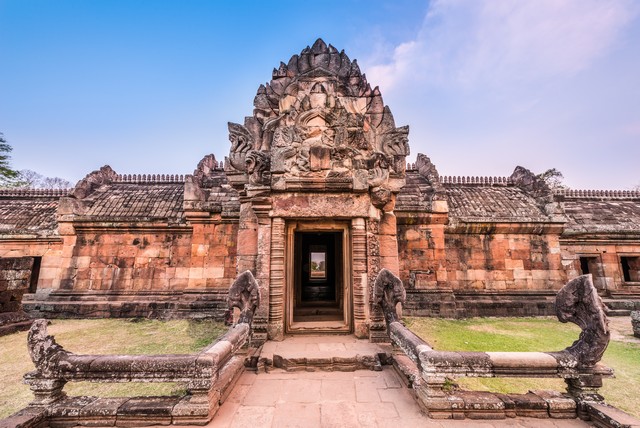
Presently, the castle has submitted to be considered as the future world heritage site the same as other stone castle among Raja Manka Complex. Nonetheless, Phanom Rung Stone Castle is one of most famous Khmer Stone Castles in Thailand, which the most renowned tourist location and a symbol of Buriram province and included as a symbolic logo for Buriram United football team as well.
Design and Architecture of Phanom Rung
1. The sanctuary
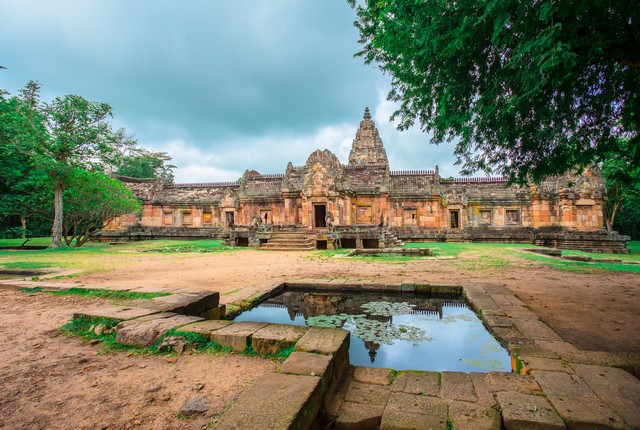
This edifice was built of sandstone and laterite in the 10th to 13th centuries. It was a Hindu shrine dedicated to Shiva, and symbolizes Mount Kailash, his heavenly dwelling. Therefore, this can reflect an esteem belief in Shiva of Hinduism very well. A structure and floor plan of the castle were designed as a cross-shape, giving the main temple a stairway that is on the right, northward, is Phlab Phla or the White Elephant House. The pavilion is believed to be the place where kings and the royal family would change attire before rituals.
2. The Long walkway

From that, one of the most impressive elements of the park is a 160-meter walkway that is long and bordered by seventy sandstone posts with tops of lotus buds. The walkway itself is paved with laterite blocks. The walkway leads to the naga bridges, the five-headed snakes face all four directions and are from the 12th century. This bridge represents the connection between heaven and earth. The naga bridge leads to the upper stairway, which is divided into five sets. Each set has terraces on the sides.
The interesting thing is at the last, made with laterite blocks it has a cruciform shape and four small pools. A couple more steps lead to the second naga bridge. It has the same shape as the first one, only smaller. In the middle, the remains of an eight petalled lotus which is referred to the god of eight directions according to Hindi and as the place to worship. From the second terrace, there is a 52-staircase leading to the outer gallery. After the outer gallery, one reaches the inner gallery, which is divided into long and narrow rooms. This last gallery leads to the third and last naga bridge, another small copy of the first one.
3. The Naga Bridge

The bridge leads directly into the main sanctuary. After the antechamber and the annex, one reaches the principal tower. Double porches lead out in all directions. The inner sanctum used to have the “linga”, the divine symbol of Shiva. Currently, only the “somasutra” remains which was used to drain water during religious rites. The entrances have various lintels and icons depicting Hindu religious stories, e.g., the dancing Shiva and the five yogis. The south entrance is guarded by a sandstone statue.
Apart from the main tower, we also able to indulge to other buildings and art pieces in the compound which are:
4. Two Bannalai
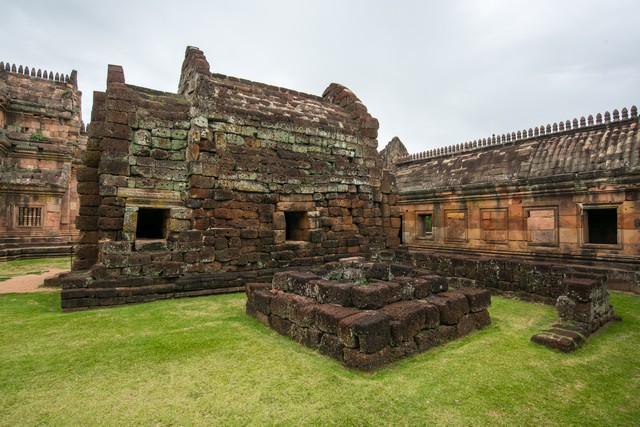
Two brick sanctuaries built around the 10th century, northeast of the tower. The minor sanctuary southwest of the tower with a sandstone altar for a sacred image. It was built with sandstone in the 11th century. Prang Noi has only one entrance facing east. The sanctuary is square with indented corners, giving it a round feel. Two Bannalai southeast and northeast of the principal tower. The buildings are rectangular and have only one entrance. They were built in the last period, around the 13th century, and used as a library for holy scriptures.
The delicate Khmer sculptures at the gable and lintel present the story of Hindi e.g. Nataraja or Dancing Shiva, the famous capital antique “Thap Lang Narai Banthomsin”, Rites and lifestyle of yogi, etc.
Highlight of Phanom Rung Historical Park
1. Phra Narai Lintel

One of the great reputation elements of this historical site is a decorative lintel placed above the eastern entrance to the central sanctuary. It depicts a reclining Vishnu or Vishnu Anantasayin, and is known in Thai as Thap Lang Narai Banthomsin or Phra Narai (Vishnu) asleep in the cosmic ocean on the back of a great serpent deity known as a Naga.
The lintel is best known for its restitution from the Art Institute of Chicago in 1988. It had been stolen from the temple site in the 1960s and was acquired by the museum in 1967, where it was displayed for over twenty years. In early 1988, as restoration of the temple neared completion, calls were made by several parties in Thailand for its return. The issue became the subject of intense media attention, with some even accusing the US Government of facilitating the theft.
The Thai government entered negotiations with the museum, which was unwilling to consider an unconditional return, since it had acquired the item in good faith. Finally, in October, the museum agreed to return the lintel in exchange for a donation from the Chicago-based Elizabeth F. Cheney Foundation. The lintel’s arrival in Thailand on 10 November was widely celebrated. It was restored to its original position on 7 December, marking the completion of the temple’s restoration.
2. Temple doors
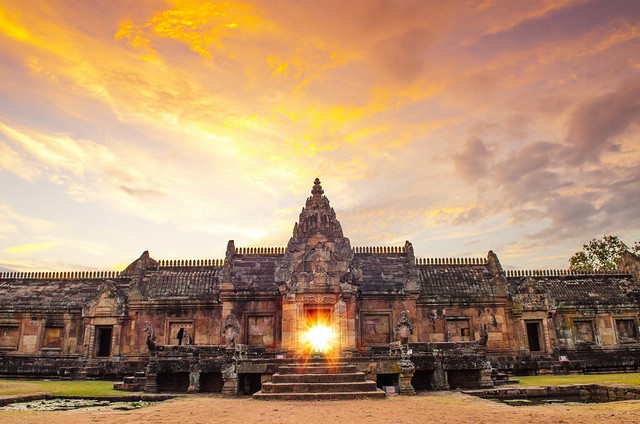
Besides the famous piece of mentioned previously, during April 3 – 5 and September 8 – 10 annually there is the sunrise that shines through all 15 temple doors. This exotic and fascinating scene attracts many tourists both domestic and from all over the world. Moreover, during March 6 – 8 and October 6 – 8 yearly at dusk the twilight shines through all 15 doors of the temple as well.
There is belief that this is some kind of sacred phenomenon and to be exposed to the sunlight which shone through the linga set in at the center of the temple can empower to life and give fortune and prosperity to life and family.
How to get to Phanom Rung Historical Park
By Car:
To travel to the Phanom Rung Historical Park from Buriram city town can choose by below following route;
- Use the highway number 218 (Buriram – Nang Rong) with the distance about 50 kilometers, then turn left to the highway number 24 (Si Kew – Ubon Ratchathani) until Ta Ko village about 14 kilomters, then turn right to enter the highway number 2117 and pass Ban Ta Pek, Chalearm Phrakiat district in about 12 kilometers, you will arrive the destination. or
- Use the highway number 219 (Buriram – Pra Kon Chai) in about 44 kilometers until Pra Kon Chai district and there is a junction which one head to Phanom Rung Historical Park and head toward in about 21 kilometers on the highway number 2075, then turn right to the highway number 2117, then you will arrive at the destination.
By Bus:
For one who is not traveling by car, you can take bus service of Trasport Company Limited and drop off at Nang Rong district terminal. From there you can hire local minibus to go to the Phanom Rung Historical Park with fare is THB200 -300 approximate (negotiable).
Once you arrive at the site, there are 2 entrances. First, at the front of the temple. From the public parking, you take staircase about 400 meters. And another is at the back of the temple which needed to access by car and there is parking with charge, and then walk about 100 meters.






